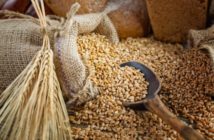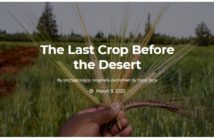BLOOMBERG
By Alan Bjerga
Further weather disruptions or rising energy expenses could increase grain costs already at a record, while current supplies may be ample enough to forestall unrest caused by high food prices, the World Bank said.
The worst U.S. drought since the 1950s sparked a 10 percent gain in the World Bank’s Food Price Index in July, the organization said today in a monthly report. Corn and soybean prices last month exceeded records in 2008, when food riots erupted in African and Middle Eastern countries. While drought in the former Soviet Union and weak monsoon rains in India are contributing to crop concerns, stable rice prices argue against a crisis situation, the bank said. That could change should energy costs increase or bad weather persist.
“World Bank experts do not currently foresee a repeat of 2008,” the multinational organization said in its report. Bans on exports, continued dry weather, poor harvests in South America or higher energy costs would worsen the situation, the bank said. “The jury is still out, for now.”
U.S. consumers may pay 3 percent to 4 percent more for food next year, a half-percentage point more than this year, as the effects of the drought works its way onto store shelves, the USDA said last week. Corn and soybean futures reached record highs this month on the Chicago Board of Trade, and wheat in July touched its highest since 2008 as crop conditions worsened in the U.S. Midwest and Great Plains.
More than 60 food riots erupted worldwide from 2007 to 2009 when global costs reached what were then all-time highs, according to the U.S. State Department. A second food-price run- up that set recordsin 2011 prompted demonstrations and violence in Mozambique, Algeria, Ugandaand elsewhere, and was cited contributing to the Arab Spring revolution in Egypt.
Higher commodity prices affect everything from meat purchased by McDonald’s Corp. (MCD) to the grain bought by General Mills Inc. (GIS) to the sweeteners used by Coca-Cola Co. (KO) The Middle East and North and Sub-Saharan Africa may be at the greatest risk of a global shock because of their reliance on imports to feed their populations, the bank said in the report.
Global nutrition costs rose 6.2 percent last month, the biggest increase since November 2009, the United Nations said earlier this month.
From April through June, white corn sold in Mozambique more than doubled in price, the World Bank said, citing examples of wide swings in food costs. Wheat in South Africasoared 27 percent during the same period, while rice sold in Tanzania fell 30 percent.
The U.S. drought may have a bigger impact on people in poorer countries that import food than on American consumers, according to Johanna Nesseth Tuttle, director for food security at the Center for Strategic and International Studies in Washington.
“Poor and middle-income countries rely on the stability the U.S. harvests bring to global food prices, so they suffer more when our production drops,” she said in an e-mail last week.
To contact the reporter on this story: Alan Bjerga in Washington atabjerga@bloomberg.net
To contact the editor responsible for this story: Jon Morgan atjmorgan97@bloomberg.net







